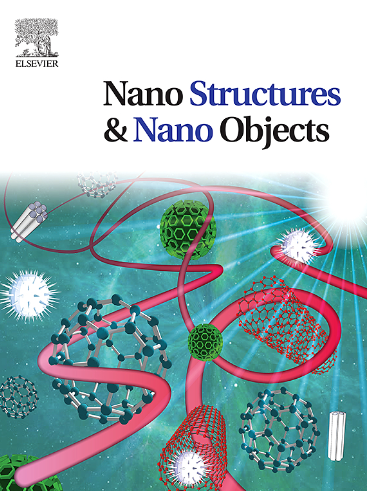多壁碳纳米管发光碳量子点:一种可持续的绿色合成方法
IF 5.45
Q1 Physics and Astronomy
引用次数: 0
摘要
以非功能化多壁碳纳米管(MWCNTs)和羟基功能化多壁碳纳米管(MWCNTs - cooh)为前驱体,采用简单环保的方法合成了发光碳量子点(CQDs)。该合成方法将MWCNTs、Theraphthal (TP)和抗坏血酸以1:1:1的比例混合在水中,然后进行离心和过滤。透射电镜(TEM)证实了cqd的球形形貌,CQD-A的平均尺寸为3.26 ± 0.57 nm, CQD-B的平均尺寸为3.46 ± 0.57 nm。傅里叶变换红外光谱(FTIR)和UV-Vis分析揭示了表面功能化和光学性质的变化。在紫外照射下观察到的绿色荧光突出了这些CQDs在生物成像和光电子学方面的应用潜力。本文章由计算机程序翻译,如有差异,请以英文原文为准。
Luminescent carbon quantum dots from multi-walled carbon nanotubes: A sustainable green synthesis approach
Luminescent carbon quantum dots (CQDs) were synthesized via a simple and eco-friendly approach using unfunctionalized multi-walled carbon nanotubes (MWCNTs) and hydroxyl-functionalized MWCNTs (MWCNT-COOH) as precursors. The synthesis involved a 1:1:1 mixture of MWCNTs, Theraphthal (TP), and ascorbic acid in water, followed by centrifugation and filtration. Transmission electron microscopy (TEM) confirmed the spherical morphology of the CQDs, with average sizes of 3.26 ± 0.57 nm for CQD-A and 3.46 ± 0.57 nm for CQD-B. Fourier-transform infrared (FTIR) spectroscopy and UV-Vis analysis revealed variations in surface functionalization and optical properties. The green fluorescence observed under UV irradiation highlights the potential of these CQDs for applications in bioimaging and optoelectronics.
求助全文
通过发布文献求助,成功后即可免费获取论文全文。
去求助
来源期刊

Nano-Structures & Nano-Objects
Physics and Astronomy-Condensed Matter Physics
CiteScore
9.20
自引率
0.00%
发文量
60
审稿时长
22 days
期刊介绍:
Nano-Structures & Nano-Objects is a new journal devoted to all aspects of the synthesis and the properties of this new flourishing domain. The journal is devoted to novel architectures at the nano-level with an emphasis on new synthesis and characterization methods. The journal is focused on the objects rather than on their applications. However, the research for new applications of original nano-structures & nano-objects in various fields such as nano-electronics, energy conversion, catalysis, drug delivery and nano-medicine is also welcome. The scope of Nano-Structures & Nano-Objects involves: -Metal and alloy nanoparticles with complex nanostructures such as shape control, core-shell and dumbells -Oxide nanoparticles and nanostructures, with complex oxide/metal, oxide/surface and oxide /organic interfaces -Inorganic semi-conducting nanoparticles (quantum dots) with an emphasis on new phases, structures, shapes and complexity -Nanostructures involving molecular inorganic species such as nanoparticles of coordination compounds, molecular magnets, spin transition nanoparticles etc. or organic nano-objects, in particular for molecular electronics -Nanostructured materials such as nano-MOFs and nano-zeolites -Hetero-junctions between molecules and nano-objects, between different nano-objects & nanostructures or between nano-objects & nanostructures and surfaces -Methods of characterization specific of the nano size or adapted for the nano size such as X-ray and neutron scattering, light scattering, NMR, Raman, Plasmonics, near field microscopies, various TEM and SEM techniques, magnetic studies, etc .
 求助内容:
求助内容: 应助结果提醒方式:
应助结果提醒方式:


